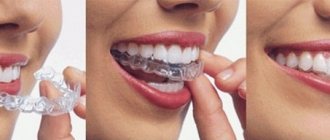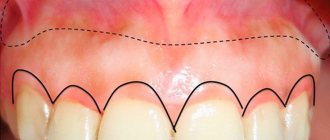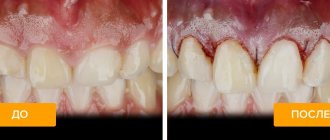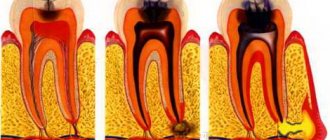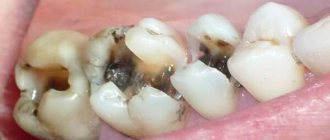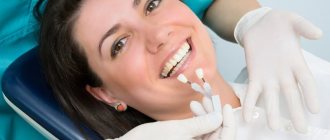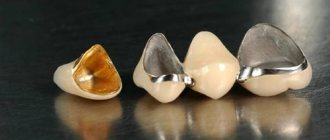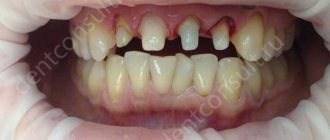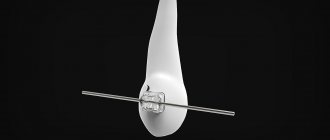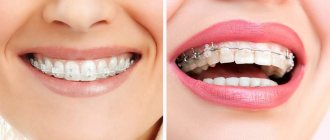For professional dental care, various methods and tools are used, among which one of the main places is grinding the enamel with subsequent polishing. The technique is used independently or simultaneously with other manipulations, for example, after removing large stone deposits. Often the method is used during preparation for other processes, for example, prosthetics or restoration with veneers.
Grinding is performed for primary processing, removal of irregularities and roughness, microcracks. At this stage, stone and soft plaque are eliminated, and caries is prevented. Polishing is carried out after grinding. They completely smooth out enamel unevenness and eliminate minor imperfections. Additionally, this step has a mild whitening effect by removing deposits. But there is a slight increase in color, as the natural shade is restored. If the purpose of the procedure is serious whitening, then the doctor uses other methods and drugs.
The essence of grinding and polishing
After professional cleaning, the surface of the teeth becomes rough, because tartar has just been removed from it. If you look at the enamel under a microscope, you will notice small grooves, cracks and depressions. Plaque will cling to these irregularities, and soon the person will again have to contact a hygienist.
The same thing happens after the filling is installed. Foreign material rises above the surface of the enamel, and plaque will very quickly accumulate at this junction, which will turn into tartar.
Attention! Grinding and polishing of teeth according to the standards of medical care are included in the process of treatment or professional teeth cleaning as a mandatory step.
To slow down the formation of unwanted growths, the surface of the tooth must be leveled (ground) and made as smooth as possible (polished). The purpose of these procedures is not so much aesthetic as hygienic, because a smooth surface is better washed by saliva, which simply washes away a significant part of the microbes, protecting the enamel from their effects. In addition, on a completely flat surface, plaque forms more slowly, because there is nothing for the deposits to cling to.
On a note! Grinding teeth after caries treatment helps remove excess filling material so that it does not affect the bite. It is impossible to carry out such a procedure at home.
Indications for grinding
It is recommended to level the enamel surface not only after professional cleaning, but also in some other cases:
- before surgery, it is important to remove plaque from the teeth so that bacteria do not enter the wound,
- At the final stage of dental treatment, it is important for the doctor to choose a filling material that matches the color of the tooth, so he does the grinding, because plaque darkens the enamel,
- when making prosthetics, it is also important to choose a crown that matches the color of the teeth, so grinding is indispensable,
- After removing the braces, the doctor thus removes plaque that accumulates under the structure and makes the surface smooth, eliminating any remaining adhesive.
Aftercare recommendations
The recommendations are mainly due to the fact that teeth become sensitive after the procedure. That is, you should avoid eating foods that seem very hot or cold.
It is also worth giving up too hard foods for a while. All this can be adjusted by trusting your own feelings regarding pain and comfort.
There are also specific tips. Thus, doctors recommend minimizing the consumption of foods that have a “coloring” effect. We are talking not only about certain berries, but also, above all, about tea and coffee.
This measure must be observed for two weeks in order to maintain the pleasant appearance of the cleaned enamel. You can at least switch to green tea at this time. You should also try to minimize smoking.
Contraindications to the procedure
Despite the fact that grinding and polishing are mandatory stages of some dental interventions, there are situations when these procedures are not performed:
- excessive bleeding gums,
- periodontitis in the acute phase,
- untreated caries,
- excessive sensitivity of enamel;
- any inflammatory processes in the oral cavity,
- allergic reactions to any component of the drugs,
- salt-free diet for acute kidney disease.
Price
The teeth grinding procedure is far from the most expensive in dentistry. For one jaw, its price varies around 1000 rubles, which for one unit is usually 100-200 rubles.
However, you need to understand that the impact of this type on one tooth is usually included in the complex of treatment of this unit, most often its filling.
Enamel polishing , on the contrary, is usually highlighted in the price list and is provided as a separate service. However, it would be reasonable to decide on a one-time payment for comprehensive oral hygiene. In this case, you will need to pay a little more than two thousand rubles for one jaw.
How to grind and polish teeth
For these procedures, the doctor uses various attachments on the drill, as well as special polishing pastes. The drill operates at 2000-5000 rpm, that is, it does not heat the enamel, and therefore does not injure it. To process similar types of surfaces, different types of attachments are used:
- rubber, flake-shaped - used to level the flat surface of crowns,
- cone-shaped brushes - help to level the chewing surfaces of the molars, which have bumps and depressions;
- strips (polishing strips with diamond coating) - they are used to process the walls of the tooth in those places where they come into contact with the sides of the neighbors.
To carry out additional surface treatment and make it smooth and shiny, dentists use pastes that differ in composition and areas of application:
- 250 (blue) – the paste contains large abrasive particles and is designed to remove the remains of hard deposits and filling material;
- 170 (green) – paste with medium-grained particles, used at the second stage of polishing;
- 120 (red) – fine paste for more gentle polishing;
- 40 (yellow) – a paste containing superfine particles intended for treating sensitive surfaces.
Interesting! The basic components in polishing pastes are silicate, silica or zirconium oxide. Some may contain xylitol and fluoride, which provide additional enamel protection.
Polishing pastes
During the procedure, special polishing pastes are used; it is desirable that they contain fluoride preparations for the remineralization of treated dental tissues and weak antiseptic agents. The composition of these pastes is close to the composition of pastes for individual oral care, however, they are more abrasive. The following is used as an abrasive filler:
- pumice,
- silicate or aluminum oxide,
- silica,
- zircon.
Polishing pastes should be available in a full range of grain sizes. They are produced in large tubes or “unidoses” (single doses). To work, it is convenient to place the polishing paste in the ring-shaped holder.
Polishing begins with a coarse polishing paste with a rubber cup, then treatment is carried out with a medium-grained paste, thanks to which the unevenness formed by the previous paste is smoothed out. Only if you follow the order of alternating polishing pastes can you obtain a smoothly polished surface.
Finally, final polishing is carried out with a fine-grained fluorine-containing paste. In addition to the gradation of pastes by grain size, an important indicator is the RDA indicator - radioactively measured dentin abrasiveness. The lower the RDA number, the lower the abrasiveness. The higher this number, the higher the abrasiveness.
Types of tooth surface grinding
Depending on the goals, inaccessibility and general clinical picture, the doctor chooses one of the types of grinding and polishing:
- mechanical (traditional): a drill with various attachments is used. The advantages are that such grinding can be performed in a dental clinic of any level,
- ultrasonic: its principle is that ultrasound of different frequencies breaks up deposits on the teeth, and then they are cleaned with special attachments. This method is also used in polishing dental roots, since ultrasonic waves have high permeability and can remove plaque in the most inaccessible places. Its advantage is the absence of vibration of the drill, which means it can also be used in pediatric dentistry,
- air (sandblasting): with this method, the doctor uses a directed stream of air containing fine abrasive particles to remove the remains of tartar from the enamel surface. The advantage is that this method is gentle on the gums,
- laser: with it, the surface is leveled with a laser beam, which has a strong disinfecting effect. The advantage is the high quality of cutting growths, but laser equipment is not available in all clinics and requires a highly qualified doctor, and this is the disadvantage of this method.
Reviews
Patients who have successfully completed the procedure note that the result debunks the myth about subsequent tooth decay. Moreover, they often write that teeth begin to look whiter and more beautiful.
Sometimes they complain of increased sensitivity, as a result of which they cannot live a normal life, for example, drink hot coffee in the morning. But a small percentage of negative reviews, most of which were the result of the dentist’s unprofessionalism, suggests that in general this procedure is useful and safe.
You can share your opinion in the comments to this article.
If you find an error, please select a piece of text and press Ctrl+Enter.
Tags: tooth enamel professional teeth cleaning ultrasonic teeth cleaning teeth cleaning
Did you like the article? stay tuned
Previous article
Biohorizon implants: features of installation and engraftment
Next article
What determines the service life of dental implants?
Preparation for the procedure
Before you begin grinding and polishing your teeth, your dentist must prepare your mouth for the process. First, carry out direct removal of deposits. This whole procedure lasts about half an hour, and to make the task easier, the doctor uses plastic mouth openers or polymer retractors that allow you to keep your mouth open.
Secondly, you need to protect your lips from the rotating parts of the drill, and to do this, the doctor places cotton swabs under them. And if it is necessary to treat a limited area, for example, a treated tooth, then the doctor uses special separating plates.
Both the doctor and the patient also wear safety glasses to prevent splashes or small particles from getting into the eyes.
How to grind and polish
Since these procedures are mainly the final stage of therapy or cleansing, the doctor first carries out the necessary manipulations. And only after the tartar is cut off and the filling is installed, grinding and polishing begins.
The doctor selects the paste and attachments, focusing on the individual clinical picture. However, the basic principles remain the same: first, flat surfaces are treated, then chewing surfaces, and only then the interdental space.
The doctor also uses pastes in a certain order: first coarse, and then fine-grained. After final polishing, the teeth are coated with a special fluoride varnish to protect the enamel from aggressive bacteria and food acid.
